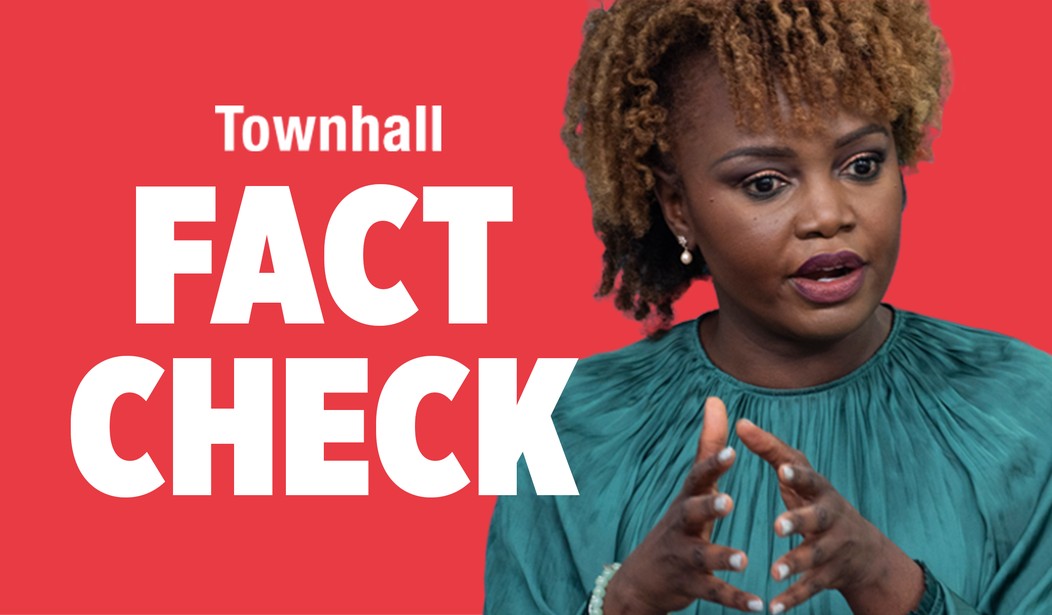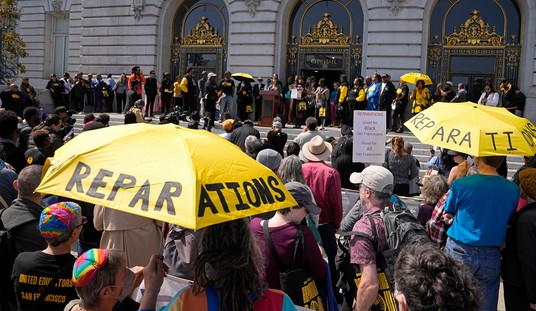As crime continues to crop up as a top concern for Americans, last week, White House Press Secretary Karine Jean-Pierre claimed that violent crime is historically low nationwide thanks to the Biden administration supposedly making the U.S. safer.
CLAIM: "Under this president's leadership, President Biden, violent crime is at a nearly 50-year low..." Jeane-Pierre claimed at the May 6 briefing. "Violent crime declined across every category in the first quarter of 2024, and murders are down 17 percent."
"Let me be clear here: This reduction in crime is no accident," she continued. "President Biden and his administration are taking historic action to make our communities safer and give our law enforcement officers the tools they need to protect and serve."
The White House brags that "violent crime is at a nearly 50-year low," and that Americans are safer today than they were a year ago today. pic.twitter.com/eHJhXCXHef
— Townhall.com (@townhallcom) May 6, 2024
FACTS: The White House cited a recent report by the Major Cities Chiefs Association (MCCA) based on preliminary Q1 data in 2024. However, those figures (from a three-month period) don't capture the full picture. Looking holistically, compared to Q1 pre-pandemic levels in 2019, homicides are up 16 percent and aggravated assaults are up 7.5 percent, the MCCA found.
Just released: Q1 violent crime report. Violent crime continues to trend ⬇️ for the majority of @MjrCitiesChiefs member agencies. When compared to Q1 2019 pre-pandemic levels, homicides are ⬆️ 16% and aggravated assaults are ⬆️ 7.5% in the USA https://t.co/aezJVSxtRC pic.twitter.com/Zt6bU2GS8f
— Major Cities Chiefs Association (@MjrCitiesChiefs) May 3, 2024
Additionally, FBI data, which the White House has also touted, does not accurately reflect America's crime crisis.
U.S. violent crime rates were likely much higher than 2023 figures reported by the FBI, according to an April report released by the Coalition for Law, Order, and Safety (CLOS), a public safety group comprised of law enforcement officials and analysts.
"[T]o say crime is down is like descending from a tall peak and standing on a high bluff, saying you are closer to the ground — a true but misleading statement," wrote the report's authors, who include CLOS President Mark Morgan, formerly the FBI's head of training and inspection. Prior to the two decades he spent in the FBI, Morgan was a Los Angeles Police Department patrol officer.
Recommended
"The truth is that violent crime is substantially elevated in major cities [...] compared to pre-2020 levels," the researchers wrote.
There's "a series of caveats attached to the FBI data that the FBI doesn't make as clear as they should," CLOS Executive Director Sean Kennedy, one of the lead researchers and an attorney for the Law Enforcement Legal Defense Fund, told Fox News Digital.
The data analysis, titled "Assessing America's Crime Crises: Trends, Causes, and Consequences," found that violent crimes have gone egregiously underreported and classifications for certain crimes have changed in the wake of the George Floyd riots.
"It is difficult to measure how much crime is under-reported, often 'downcharged,' by law enforcement since the number of reported crimes reflects the categorizations of police agencies themselves," according to the 35-page report analyzing FBI data.
Several police departments have redefined how crimes are categorized and transitioned away from a decades-old recording system, Kennedy told Fox News. "If you classify something as an aggravated assault, it's a violent crime or a felony, but if you classify it as a simple assault, it's then a misdemeanor and a non-violent crime," he explained. "That is a world of difference when it comes to how the media is going to portray whether or not your department is fighting violent crime."
Last month, the New Orleans Police Department announced they had under-reported sex crime data that was furnished to the FBI in 2021 (501 reported rapes vs. 696 actual) and 2022 (442 to 672); some cases that are considered rape by federal standards were reported as sexual battery, indecent behavior, or molestation. In 2014, a Los Angeles Times investigation discovered that the LAPD had systematically downgraded violent crimes. LAPD misclassified approximately 14,000 serious assaults as minor offenses over an eight-year timeline, "artificially lowering" the city's crime levels, The LA Times found.
#NOPD today briefed media re: a recently discovered error regarding crime data reported by the department’s Special Victims Section for the years of 2021 and 2022, and how the department is working to correct the reporting. MORE INFO HERE: https://t.co/7lDIXNGQ58 pic.twitter.com/A1r8TptTix
— New Orleans Police Department (@NOPDNews) April 2, 2024
Democrats are also taking advantage of missing FBI data to claim that crime is down, crime watchdogs warn. This information gap is "sure to be exploited by politicians this election year" and so on, the Marshall Project cautioned ahead of the midterms.
In 2021, the FBI fully implemented a new crime-data collection system called the National Incident-Based Reporting System (NIBRS), replacing the old way of collecting data from local law enforcement. The move plummeted police participation from 85.4 percent of agencies in 2020 to 62.7 percent the following year. Several large cities (New York, Los Angeles, and Chicago) failed to submit any NIBRS data in 2021, and of the ones that did comply, they didn't send full-year or complete incident-level data.
Today, many Democrat-led cities still don't submit crime data in full or at all to the federal government, as Spencer previously covered. According to reporting rates monitored by the Marshall Project, nearly one-third of law enforcement agencies (31 percent of the 18,000) were MIA from the FBI's 2022 crime statistics. Among those that failed to report to the FBI's database:
- New York City Police Department
- Los Angeles Police Department
- San Jose Police Department
- San Francisco Police Department
- New Orleans Police Department
- Pittsburgh Police Department
- Kansas City Police Department (Kansas)
- Phoenix Police Department
The cost is high, and the transition is onerous. San Francisco police don't plan on submitting crime data to the FBI until 2025, the department's chief information officer told the Marshall Project. The agency has asked city leaders for nearly $5 million each year to implement a new NIBRS-compliant record management system, according to the proposed budget for FY 2022 through 2024
In 2016, the federal government gave San Diego (now fully compliant) $2.7 million for its transition project implementing NIBRS.
In order to compensate for incomplete data, the FBI started filling in gaps by "inferencing" based on statistical sampling.
"To adjust for the absence of NIBRS data, the FBI uses estimates to calculate the total number of offenses that would likely have been reported to law enforcement in aggregate," CLOS says. So, there's a level of uncertainty in the accuracy of the FBI's data.
 Visual example of how the FBI displays its estimated data | Source: CLOS
Visual example of how the FBI displays its estimated data | Source: CLOS
Last year, the U.S. Department of Justice (DOJ)'s Bureau of Justice Statistics described the estimation model:
"It is the statistical process which allows inferences to be made about an outcome of interest in a population (e.g., the number of murders in the United States), even if information about the outcome is only known for part of the population [...] Not all law enforcement agencies submit all their crime data; some provide only partial data, or no data at all, on crimes and arrests."
In other words, the FBI figures are "a guess – albeit an informed guess – built on assumptions to fill in data that is often otherwise known (i.e., the number of homicides in Los Angeles in 2021 – 402)," CLOS says. Because the LAPD did not submit NIBRS data, the FBI inferred what the number would likely have been, despite the data being publicly available in its yearly report.
Since factors or events can shift such totals, the estimates are susceptible to errors and subject to being "wildly wrong," CLOS says. For example, if the FBI were to estimate Baltimore's homicides for 2015, the figures would be "off significantly." Baltimore saw Black Lives Matter riots, de-policing, and prosecutorial policies that such a statistical model would probably not account for.
Consequently, "[t]his methodological problem of inferring reported offenses plagues the FBI's estimated aggregate crime totals to the point that the data misleads instead of informing policymakers, the media, and analysts on crime trends," CLOS concludes.
"FBI data is taken as gospel truth, when the FBI itself puts a series of footnotes all over their own data," Kennedy said.
Local police are not the only ones appearing to under-report.
Business owners who are victims of violent crimes are likely reluctant to call the police. According to the Loss Prevention Research Council's 2022 survey of retailers, the study shows that some business owners believe that the police will not respond promptly or investigate the crimes properly (let alone solve) and prosecutors will not pursue charges against the perpetrators.
The latter reason for the lack of reporting can be explained by the progressive policies of soft-on-crime district attorneys and state-level changes that have increased the threshold for theft to constitute a felony, thus reducing the penalties for petty theft.
"If there is little likelihood that reporting the crime will yield results, many victims are discouraged to do so," CLOS explains.
CLOS identified four factors that have helped cause an increase in crime across most major U.S. cities as a lack of faith in law enforcement persists: de-policing (i.e. defunding the police), de-carceration, de-prosecution, and politicization of the criminal justice system (via politically motivated prosecutors regularly downgrading felonies to misdemeanors or opting not to prosecute).
As for heavily insured, large corporations, which are often risk-verse, theft is built into the business model, and retailers actively discourage employees from stopping thieves and reporting shoplifting to authorities, CLOS says. Retail-sale losses have doubled since 2019 from $62 billion to $122 billion, which is projected to rise to $143 billion by 2025, per the National Retail Federation.
Outside of retail, the reporting rate to police for property crime is remarkably low. This is particularly apparent, CLOS observes, when comparing the National Crime Victimization Survey (NCVS) crime category of "other theft" to its FBI equivalent ("larceny-theft"). In 2019, the FBI tallied 5.2 million "larceny-theft" offenses compared to 10.1 million "other thefts" reported to the NCVS, only representing half of the victim-attested crimes. By 2022, the FBI reported that that number fell to 4.67 million offenses, but victims had reported 10.7 million, a 6 percent increase, while the FBI claimed a 9.5 percent decline over that three-year period.
Meanwhile, the victim survey recorded a 30 percent increase in robberies between 2019 and 2022; the FBI measured an 18 percent decline. Violent victimizations, excluding homicides and simple assault, have swelled from around 2 million in 2019 to almost 2.8 million in 2022, and the annual number of aggravated assaults increased by over half a million, according to the NCVS; the FBI estimated that aggravated assaults only slightly rose by 100,000 between 2019 and 2020 before falling in 2022.
Homicides and carjackings also continue to climb. According to research conducted by the nonprofit Council on Criminal Justice (CCJ), across 32 studied cities, the homicide rate was 18 percent higher in 2023 than in 2019, and carjackings skyrocketed by 93 percent across 10 reporting cities (where data is available since agencies are not required to report carjackings).
In human terms, there were 4,000 more people slain across the country in 2022 than in 2019, a rise of 27%: https://t.co/gR3xpJcBtQ pic.twitter.com/qkkadQOSFo
— Council on Criminal Justice (@CouncilonCJ) March 7, 2024
Other official government data sources conflict with and diverge from the FBI's crime statistics.
For example, in 2022, the FBI reported roughly 21,150 "murders and non-negligent homicides." Compare that to the Centers for Disease Control and Prevention (CDC) documenting over 24,800 homicides, a difference of approximately 3,700 violent deaths. The reporting discrepancy between agencies has worsened since the FBI switched to the new NIBRS system, CLOS notes.
RATING: The White House's claim that violent crime is at its lowest level in 50 years under Biden is FALSE.
Depending on the source, nationwide crime data can be inconsistent, unreliable, and too skewed to track trends with precision.
According to CLOS's findings, crime has risen dramatically over the past few years and may be worse than FBI statistics suggest due to issues with reporting and methodology. The myriad of flaws, including a discrepancy between officially reported offenses and self-reported victimization, calls into question the veracity of claims that crime is trending downward in Biden's America.
























Join the conversation as a VIP Member